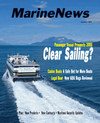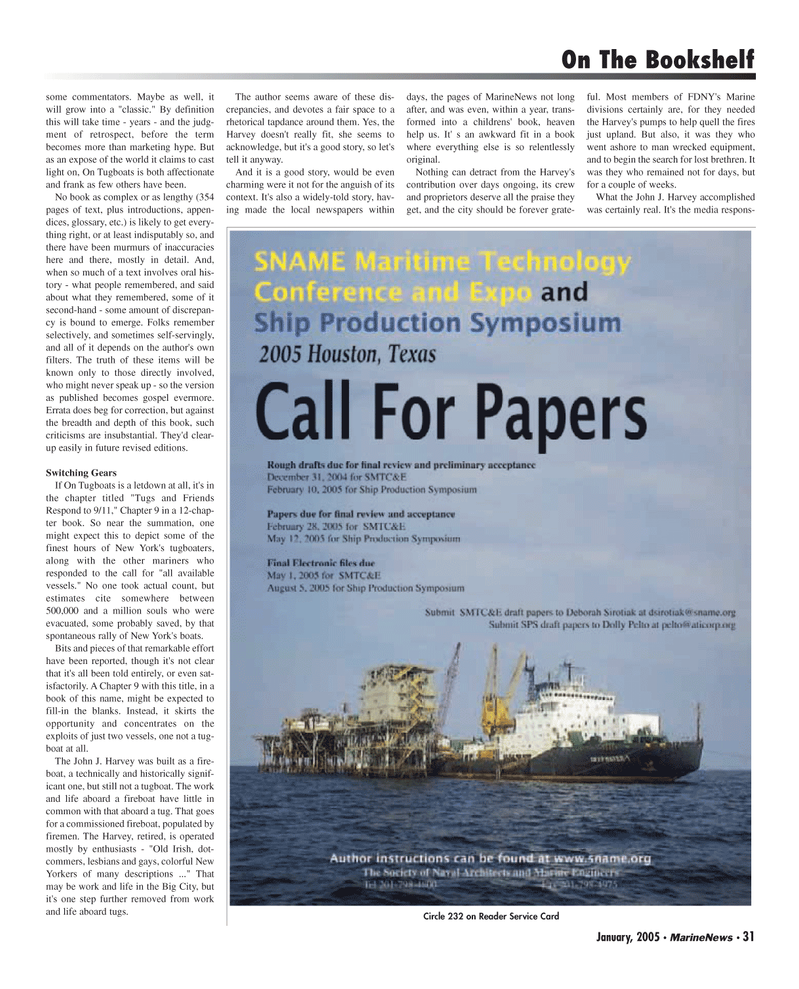
Page 31: of Marine News Magazine (January 2005)
Read this page in Pdf, Flash or Html5 edition of January 2005 Marine News Magazine
some commentators. Maybe as well, it will grow into a "classic." By definition this will take time - years - and the judg- ment of retrospect, before the term becomes more than marketing hype. But as an expose of the world it claims to cast light on, On Tugboats is both affectionate and frank as few others have been.
No book as complex or as lengthy (354 pages of text, plus introductions, appen- dices, glossary, etc.) is likely to get every- thing right, or at least indisputably so, and there have been murmurs of inaccuracies here and there, mostly in detail. And, when so much of a text involves oral his- tory - what people remembered, and said about what they remembered, some of it second-hand - some amount of discrepan- cy is bound to emerge. Folks remember selectively, and sometimes self-servingly, and all of it depends on the author's own filters. The truth of these items will be known only to those directly involved, who might never speak up - so the version as published becomes gospel evermore.
Errata does beg for correction, but against the breadth and depth of this book, such criticisms are insubstantial. They'd clear- up easily in future revised editions.
Switching Gears
If On Tugboats is a letdown at all, it's in the chapter titled "Tugs and Friends
Respond to 9/11," Chapter 9 in a 12-chap- ter book. So near the summation, one might expect this to depict some of the finest hours of New York's tugboaters, along with the other mariners who responded to the call for "all available vessels." No one took actual count, but estimates cite somewhere between 500,000 and a million souls who were evacuated, some probably saved, by that spontaneous rally of New York's boats.
Bits and pieces of that remarkable effort have been reported, though it's not clear that it's all been told entirely, or even sat- isfactorily. A Chapter 9 with this title, in a book of this name, might be expected to fill-in the blanks. Instead, it skirts the opportunity and concentrates on the exploits of just two vessels, one not a tug- boat at all.
The John J. Harvey was built as a fire- boat, a technically and historically signif- icant one, but still not a tugboat. The work and life aboard a fireboat have little in common with that aboard a tug. That goes for a commissioned fireboat, populated by firemen. The Harvey, retired, is operated mostly by enthusiasts - "Old Irish, dot- commers, lesbians and gays, colorful New
Yorkers of many descriptions ..." That may be work and life in the Big City, but it's one step further removed from work and life aboard tugs.
The author seems aware of these dis- crepancies, and devotes a fair space to a rhetorical tapdance around them. Yes, the
Harvey doesn't really fit, she seems to acknowledge, but it's a good story, so let's tell it anyway.
And it is a good story, would be even charming were it not for the anguish of its context. It's also a widely-told story, hav- ing made the local newspapers within days, the pages of MarineNews not long after, and was even, within a year, trans- formed into a childrens' book, heaven help us. It' s an awkward fit in a book where everything else is so relentlessly original.
Nothing can detract from the Harvey's contribution over days ongoing, its crew and proprietors deserve all the praise they get, and the city should be forever grate- ful. Most members of FDNY's Marine divisions certainly are, for they needed the Harvey's pumps to help quell the fires just upland. But also, it was they who went ashore to man wrecked equipment, and to begin the search for lost brethren. It was they who remained not for days, but for a couple of weeks.
What the John J. Harvey accomplished was certainly real. It's the media respons-
January, 2005 • MarineNews 31
On The Bookshelf
Circle 232 on Reader Service Card
MN JAN05 3 (25-40).qxd 1/4/2005 3:32 PM Page 31

 30
30

 32
32
